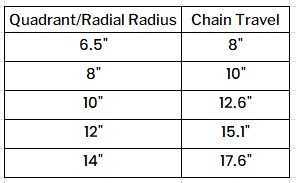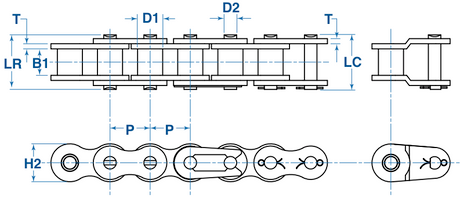Chain size and length, explained
Posted by Dave on Apr 25th 2023
There are two key chain measurements that you must know in order to replace your chain: length and size. Both are straightforward. "Size" refers to the pitch (length) and width of each link. There are two common chain sizes that likely cover everyone: #50 and #60. These sizes refer to ANSI (American National Standards Institute) Roller Chain Standard chain dimensions. #50 chain has a 5/8" pitch (measure from center of one roller link to another) and a width of 3/8" between links (measured inside the chain). #60 chain has a 3/4" pitch and a .5" width. These two dimensions are called out as "P" and "B1" in the photo below. Your boat is set up for either one of these, that's the size that fits on your pedestal's sprocket, and that's the size you need.

Edson's chain kits, and chain and wire kits, are sold with 1.5', 2', and 2.5' chain lengths. The way we measure chain is overall length, without attachment hardware - no master links, no shackles, no nothing. This isn't really the most precise engineering way to measure it, which would be counting the number of pitches, but it absolutely gets us close enough. People often call and say "I need a 26" chain" but really they have a 24" chain with master links on either end (master links look like the right-most link in the chain pictured above, with the clevis pins).
Chain length is dictated by the chain travel, which is the distance that your
chain moves while turning the wheel from hard over to hard over. Another factor
in chain length is the degrees of rudder turning, but in almost all cases this
is 72* (36* in each direction), so we’ll treat that as a constant. Chain travel
is a total distance, so if a boat has 12" of chain travel, that means the
chain moves 12" from hard over to hard over.
If a boat has 12" of chain travel, the chain needs to go 6" up to turn from straight ahead to hard over in one direction, and 6" down to turn from straight ahead to hard over in the other direction. So long as the chain is long enough to do that, it's long enough.* Since the chain must ride over the sprocket, which in a typical 11 tooth sprocket takes about 3.5", we need to add that to a 12" chain to have the minimum usable chain length.
In all of our standard pedestals, and in the huge majority of pedestals in general, the steerer shaft is 28" above the cockpit floor. This means that the chain has room to go 14" up and 14" down, which means a 28" chain plus the length needed to go over the sprocket (typically 3.5") is the maximum length that will work in a standard pedestal. A 30" chain, which accommodates about a 27" chain travel, is the longest chain that will work in a standard pedestal. These minimums and maximums correspond nicely with our standard chain lengths.

We’ll discuss helm loading in another post, but the big variable driving chain travel is radial or quadrant size (radius). The bigger that radius, the longer the chain travel. Almost all of the quadrants and radials we sell have a radius between 6.5” and 14”. Basically, the larger the boat, the bigger the radius. Across this range of radii, the chain travel varies from 8” on a 6.5” quadrant/radial to 17.6” on a 14” quadrant/radial (see table above). Since a 24” chain is not too long to work in a standard pedestal, and the 17.6” chain travel is easily accommodated by the 24” chain length, most boats can happily use a 24” chain.
There are exceptions to this, but they're unusual.
*This assumes the chain is centered on the sprocket, as per this post. If the chain is off center, it decreases the available chain travel in both directions.

